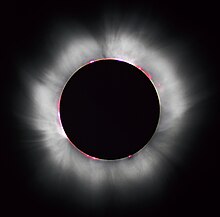1999 in science
| |||
|---|---|---|---|
The year 1999 in science and technology involved some significant events.
Aeronautics[]
- February 27 – While trying to circumnavigate the world in a hot air balloon, and set a new endurance record after being in their balloon for 233 hours and 55 minutes.
- March 3–20 – Bertrand Piccard and Brian Jones successfully complete a non-stop circumnavigation of the world in a hot air balloon.
Astronomy and space exploration[]

Total solar eclipse of August 11, viewed from France
- January 31 – A total penumbral lunar eclipse
- February 7 – Stardust is launched on a mission to collect samples of a comet coma, and return them to Earth.
- February 16 – Annular solar eclipse, visible from Australia.
- July 20 – Mercury program: Liberty Bell 7 is raised from the Atlantic Ocean.
- July 28 – Partial lunar eclipse, visible from Australia, eastern Asia, and western North America.
- July 31 – NASA intentionally crashes the Lunar Prospector spacecraft into the Moon, thus ending its mission to detect frozen water on the moon's surface.
- August 11 – Total solar eclipse, visible from Europe, across the Middle East, and ending in India.
- December 16 – The Beethoven Burst (GRB 991216) is one of the most powerful detected Gamma-ray bursts.
- NASA loses two Mars probes, the Mars Climate Orbiter and the Mars Polar Lander.
- The Subaru 8.3 m and Gemini North 8.1 m reflecting telescopes open at the Mauna Kea Observatory in Hawaii.
- The Cetus Dwarf galaxy is discovered.
- M–sigma relation first presented.[1]
Biology[]
- November 1 – Agreement on the Conservation of African-Eurasian Migratory Waterbirds comes into force.
- Late – Pest-exclusion fence around Zealandia (wildlife sanctuary) in Wellington, New Zealand, completed.
- The bacterium Thiomargarita namibiensis is discovered off the coast of Namibia. At 0.3mm in diameter, it is largest bacteria yet discovered.
Chemistry[]
- Elements 118 and 116 are claimed to be made for the first time. Later retracted when results could not be replicated.
Computer science[]
- March 26 – The Melissa worm attacks the Internet.
- June – RFC 2616 defines HTTP/1.1, the version of Hypertext Transfer Protocol in common use.
- September 21 – David Bowie's Hours becomes the first complete music album by a major artist available to download over the Internet in advance of the physical release.[2]
- First working 3-qubit demonstrated at IBM's Almaden Research Center. First execution of Grover's algorithm.
- Probable date – First emojis introduced, in Japan.[citation needed]
Geology[]
- January 25 – A 6.0 Richter scale hits western Colombia, killing at least 1,000.
- August 17 – The 7.6 Mw İzmit earthquake shakes northwestern Turkey with a maximum Mercalli intensity of IX (Violent), leaving 17,118–17,127 dead and 43,953–50,000 injured.
History of science and technology[]
- Boris Chertok publishes «Ракеты и люди» (Rockets and people), a history of the Soviet rocket program.
Mathematics[]
- Eric M. Rains and Neil Sloane extend tree counting.[3]
- Thomas Callister Hales proves the honeycomb conjecture.[4]
Paleontology[]
- First fossil of Kenyanthropus Pliocene hominin discovered in Lake Turkana, Kenya.
Physics[]
- June 18 – Bulgaria becomes a member of CERN.
- October 25 – Randall–Sundrum model presented by Lisa Randall and Raman Sundrum.[5][6]
Physiology and medicine[]
- Huda Zoghbi demonstrates that Rett syndrome is caused by mutations in the gene MECP2.[7]
Telecommunications[]
- The first BlackBerry is released, using the same hardware as the Inter@ctive pager 950, and running on the Mobitex network.
Awards[]
- Nobel Prizes
- Physics – Gerardus 't Hooft, Martinus J.G. Veltman
- Chemistry – Ahmed H. Zewail
- Medicine – Günter Blobel
- Turing Award: Fred Brooks
- Wollaston Medal for Geology: John Frederick Dewey
Deaths[]
- February 21 – Gertrude B. Elion (b. 1918), American pharmacologist, Nobel laureate in Physiology or Medicine.
- February 25 – Glenn T. Seaborg (b. 1912), American physical chemist, Nobel laureate in Chemistry.
- March 17 – Herbert E. Grier (b. 1911), American electrical engineer.
- April 28 – Arthur Leonard Schawlow (b. 1921), American physicist, Nobel laureate in Physicist.
- May 8 – Edward Abraham (b. 1913), English biochemist.
- May 26 – Waldo Semon (b. 1898), American inventor.
- July 8 – Pete Conrad (b. 1930), American astronaut.
- November 11 – Vivian Fuchs (b. 1908), English geologist and explorer.
- November 25 – Pierre Bézier (b. 1910), French engineer.
References[]
- ^ Merritt, David (1999). Combes, F.; Mamon, G. A.; Charmandaris, V. (eds.). Black holes and galaxy evolution. Dynamics of Galaxies: From the Early Universe to the Present. 197. Astronomical Society of the Pacific. pp. 221–232. arXiv:astro-ph/9910546. Bibcode:2000ASPC..197..221M. ISBN 978-1-58381-024-8.
- ^ Cummings, Sue (1999-09-22). "The Flux in Pop Music Has a Distinctly Download Beat to It". The New York Times. Retrieved 2013-11-01.
- ^ Crilly, Tony (2007). 50 Mathematical Ideas you really need to know. London: Quercus. p. 117. ISBN 978-1-84724-008-8.
- ^ Hales, Thomas C. (January 2001). "The Honeycomb Conjecture". Discrete and Computational Geometry. 25 (1): 1–22. arXiv:math/9906042. doi:10.1007/s004540010071. MR 1797293.
- ^ Randall, Lisa; Sundrum, Raman (1999). "Large Mass Hierarchy from a Small Extra Dimension". Physical Review Letters. 83 (17): 3370–3. arXiv:hep-ph/9905221. Bibcode:1999PhRvL..83.3370R. doi:10.1103/PhysRevLett.83.3370.
- ^ Randall, Lisa; Sundrum, Raman (1999). "An Alternative to Compactification". Physical Review Letters. 83 (23): 4690–3. arXiv:hep-th/9906064. Bibcode:1999PhRvL..83.4690R. doi:10.1103/PhysRevLett.83.4690. S2CID 18530420.
- ^ Amir, Ruthie E.; Van den Veyver, Ignatia; Wan, Mimi; Tran, Charles; Francke, Uta; Zoghbi, Huda Y. (1999). "Rett syndrome is caused by mutations in X-linked MECP2, encoding methyl-CpG-binding protein 2". Nature Genetics. 23 (2): 185–8. doi:10.1038/13810. PMID 10508514.
Categories:
- 1999 in science
- 20th century in science
- 1990s in science
